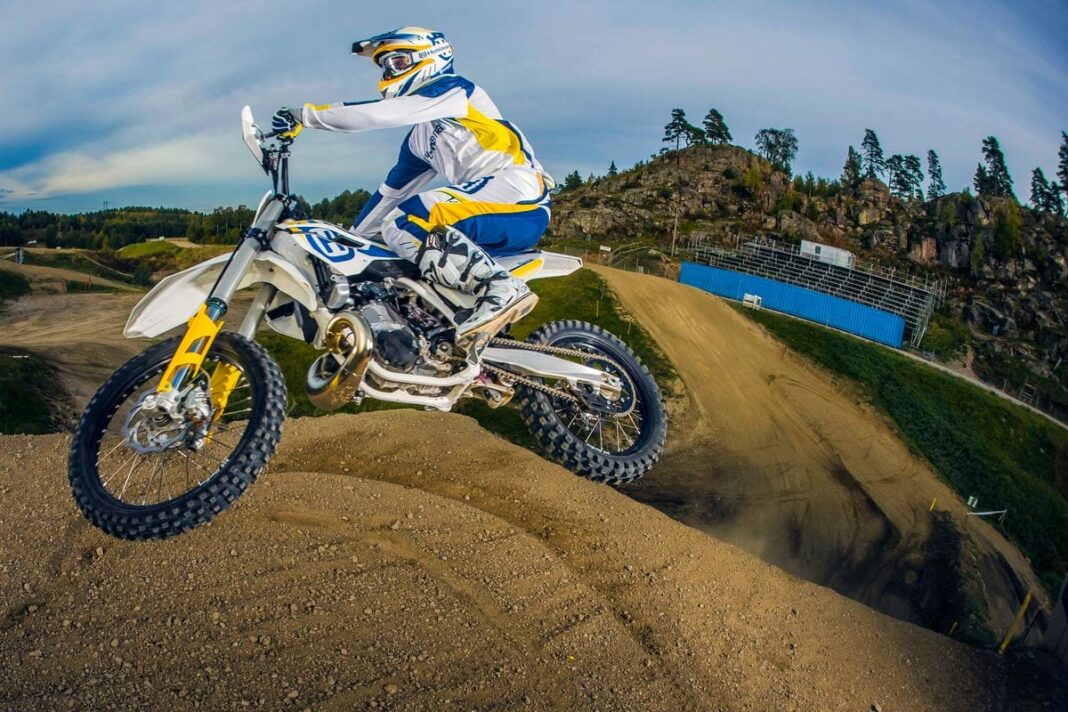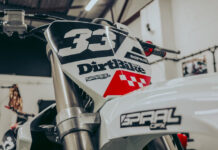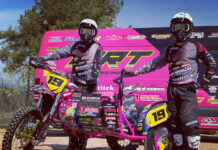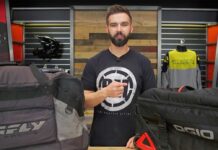Test ape Wakker goes bananas in his pyjamas for the all-new KTM-esque range of Husqvarnas…
The Husqvarna name is synonymous with dirt bikes and is one of the oldest brands in our culture. Born in Sweden the production of bikes began in 1903 but it wasn’t until 1918 that the first fully in-house designed, developed and produced Husqvarnas hit the roads. The company concentrated on road bikes at first and began racing in the 1920s at events such as the TT. It was the mid-50s when off-road riding and racing started to become more popular so two-strokes from the range were developing into off-road capable machines which developed into the two and four-stroke bikes used in the ’60s and ’70’s by legends such as Malcolm Smith, Torsten Hallman and of course Hollywood superstar, Steve McQueen.
Development and racing from the very Swedish – Electrolux Group owned – company kept going in their homeland until 1987 when the motorcycle division was sold to the Italian Cagiva MV Agusta Group. This move gave rise to some of the disgruntled Husqvarna top development and engineering staff beginning a new Swedish brand called Husaberg while Husqvarna production moved to Varese in Italy where the brand kept developing. The next chapter came with the BMW Group buying the company in 2007 which brings us up to March 2013 when Husqvarna joined the ‘KTM family’…
With this takeover there are many positives. For one thing the brand stays alive and that is key. The core to Husqvarna is the history which goes with the name and with the new owners comes an insured development strategy which will, I am told, develop Husqvarna into a unique brand of motorcycle over the next few years.
Yes there are of course going to be some ‘orange’ flavour around at this stage but as I said a couple of years ago when the Husaberg brand joined with KTM there are certain things which make a dirt bike work well and these are what every manufacturer must ensure they do well in this modern era.
When we break the bikes we ride down to simple terms they have a frame, with every manufacturer building and running very similar working angles as well as, swing arm lengths, wheelbase, wheel size, seat height, peg position, suspension travel etc. Simply put, no one modern bike is far and away better/worse than another. Choice and brand preference is key and taking a base model of what already works and upgrading it as Husaberg/KTM did will always work in my opinion.
Economics determine some of the moves by manufacturers and it is not uncommon for manufacturers to use parts and engines from ‘rivals’ such as the Beta and KTM working relationship with the use of each other’s engines in mini bikes and enduro and who can forget the KX-F/RM-Z250 and KX/RM 65 -bikes with a simple change of plastic colour. Sustainability works and bringing back the Husqvarna and Husaberg brands together after 25 years will undoubtedly work to create another incredibly strong European brand in MX and Enduro.
So, how could Husqvarna’s new owners make a range of bikes and re-launch the brand in just seven months? The answer was of course to take already proven bikes, make some changes and upgrades where possible to give the customer a strong package with a new identity. This will allow riders to hand over their hard earned moolah for a proven dirt bike with parts and support readily available to move forward and enjoy the experience of their new ride…
The 2014 Husqvarna MX range has a six bike line up and the Enduro range has seven. The motocross range includes the TC 85 which looks cool in its white, blue and yellow styling. The other two-stroke bikes are the TC 125 and 250 – which there is a 300 kit that will add a little va va voom to the package. The four-stroke MX bikes are three in number and these are the FC250, 350 and 450. The Enduro range has seven bikes to cover pretty much every rider – the two-stroke TE 125, 250 and 300 models are partnered by the FE 250, 350, 450 and 501.
With Husqvarna having such a strong and historical link to Sweden it was fitting to test the bikes at the awesome Uddevalla MXGP facility just north of Gothenburg. The MX track at Uddevalla needs no introduction while the enduro loop on this massive site is absolutely kick ass when it comes to offering a technical challenge that really lets you get a feel for a dirt bike.
The motocross bikes look great in the classic colours and the styling through the plastics and into the all in one Polyamide sub-frame is a touch of quality. I really like the look of the bikes and the assurance of proven technology with a fresh approach takes the guess work out of the range.
The theme running through the adult Husqvarna MX range is the shock length which the company are taking from an American style of set-up. The bikes sit low for precise handling and stability without compromising rider comfort. The tyres are supplied by Dunlop in the form of the Geomax MX51. All the adult bikes run with a five speed gearbox except the 125 which runs with six-speed. The 85 also runs with a six-speed.
FC450
The big bike aiming for world glory was something I was keen to get to grips with on the test. With 60 bhp on tap this bike could be classed as a handful but in my opinion this is what a big bike should be all about. When I first sat on the bike the seat height felt slightly on the low side but as soon as I took to the track the benefits of the running height became clear.
The track was frozen and a little slushy in a few places so early laps were pretty tentative for all of us. The lines would eventually cut in allowing parts of the track to be attacked.
Basically the 450 likes to be ridden with a certain freedom and its limits are pretty difficult to find. The handling after setting the sag as close as it could be for my weight and slowing the rebound on the forks and shock was very good and would get better as the lines cut in.
The biggest issue on handling came from the stock tyres. The Dunlop MX51s did not work great on the difficult surface for a good part of the day. The positive feedback from the tyres came when the bike engaged into a rut or a dry section of track. The bike would skate as the mud clearance was not great at any speed. From a riders point of view this is easily fixed and had conditions been less technical this issue would not have arisen.
The comfort on the bike was good although taller riders may want to go for a higher seat to aid with seated to standing transfer forces on their legs. The mapping switch on the handlebars comes into its own on the 450 and with the mellow curve engaged pretty much any rider can enjoy this bike. The way the bike puts the power down is not to everyone’s liking but I found the motor easy to ride hard or smooth as required on the Uddevalla circuit.
FC350
Any 350 brings a smile to my face as the unique characteristics of the capacity allow a riding style which makes for a lot of fun. The power on the Husqvarna felt stronger than I have experienced before and it was super easy to ride on both mapping curves. I left the curve on the maximum power output and the linear power from very low revs allowed traction and forward motion to occur with no drama whatsoever…
Of all the bikes, I crashed more on this one, simply because I was having a blast while trying to push it to the turns as hard as I could. My kit took a pounding as well as my body but the smile never went away…
The turning prowess through the chassis set up was at its best on the 350 as even with the slight negative feel from the tyres it allowed great mid corner speed in and out of ruts.
The WP suspensions bottoming resistance was fully tested on the 350 as there were a few slightly ‘short’ landings from great heights during the test on some of the huge Uddevalla jumps. The units took the hits no problem and I am thankful for the technology involved…
FC250
This bike begs to be ridden as hard as possible. There is no need for a mapping switch with the FC250 although it is a nice touch. Traction control can be easily dealt with by using the throttle correctly and with almost the same stability and cornering prowess as its big brothers the 250 will be a force to be reckoned with.
The suspension on the 250 was fractionally stiffer in feel to the big bikes as it would move around more on the exit to the turns and slide at high speed entering the braking zones. I tested and re tested and the feeling remained on the bike.
The light nature of the bike brought the tyre issue to the fore for me as the lack of bite versus the need to attack the turn entries was not matching up. The motor is a joy as it produces great power from zero and builds through the range. This bike is fast, very fast for a stock machine with horsepower figures out of the box which you would have to spend a lot of money on to find on some other bikes.
TC125
Riding any 125 is like going back in time and the excitement of letting it all hang out and making a lot of noise while not getting anywhere too quickly is something I remember from my youth. Well, times have changed and on the TC125 you do get places pretty quickly. This bike rips… It really is that simple.
As with every 125 ever produced you have to keep it ‘on the pipe’ and when you do this is an incredibly rewarding ride. I cannot emphasis enough just how cool it is to have a bike this quick. The Uddevalla track was perfect for the 125 as there is room to cut it loose. Of all the bikes the 125 took a few more laps to get used to as taking a bike to what seems like its breaking limit for 100 per cent of the lap seems strange for a while.
The suspension and everything about the chassis felt great on the bike with superb balance and control with no sign of the slight nervousness of either 250. The softer set-up on the 125 worked great.
FE501
The big daddy of the enduro range is also the smoothest in nature and of the entire range it is easiest to feel the benefit of the linkage rear end as the ratios versus the damping rates in the shock work in harmony to produce a bike – and indeed a range of bikes – which put the power to the ground in a delicate way when required. In low speed situations the friendly feeling from the rear of the bike acts to find traction and will cover a greater variety of situations on every day trails allowing a comfortable and controlled ride for all.
The fact that the 501 is so easy is a positive which continues throughout the range. Couple the great feeling rear end to the WP4CS forks and you are on to a good package. The forks as usual felt a little soft for my personal taste but I kept to a formula of 8 clicks in on compression and rebound on every bike I tested across the range to keep a consistency of ride. The reaction to this adjustment is incredibly positive with the 4CS fork as the feedback is there in the feeling straight away.
The power from the 501 is fantastic although you probably have to take it to Santa Pod to get it up to maximum speed. The thing just keeps pulling…
FE450
The technical nature of the rocky and rooty test lap made feeling the bikes strengths pretty easy. With the 450 and 501 the ‘big bike’ feel was there as it should be. It is not possible to have these bikes feel like toys so the trade off is the power and indeed the way it is produced. I didn’t used to be a fan of any 450-engined enduro bike as the power would have a hit to it in the mid-range. Those days are now gone and the smooth and almost docile feeling to the power up to mid range allows you to cover the ground deceptively fast. Turning on tech sections of the track had to be set up in advance but with the smooth power delivery and link working to allow traction in the most difficult conditions set up and easy cornering in every technical section was always controlled.
FE350
Could this be the best bike in the entire range… The 350 certainly holds its hands up and makes a very positive case for itself. Everything about this bike makes you want to ride. It feels very positive in every department and as with the rest of the enduro range the stock Michelin tyres provide the stability and consistency in grip where the chassis can work to its optimum performance.
The power was perfect for the test lap and with the extra flickaboutability over the bigger capacity bikes the line choices could be dealt with easily when the number one line was missed. There is a confidence this bike would bring to any off-roader, whether they were a novice or expert which is hard to find. The 350 is a user friendly bike with a sharp bite for the top level.
FE250
The FE250 is a demon in the woods and a blast on the MX track. The conditions during the two day test got more and more moist and the FE 250 loved it. The grip and feel from the bike as well as a superb free-revving motor when out in the open made this bike a blast.
As I expected it ate up the beaten enduro lap but the biggest fun was on the MX track. Riding a bike on its limit is great fun and the blend of the great tyres, positive feeling chassis and free to run motor made the 40 minute session on the track go in the blink of an eye even though it was raining that wet kinda rain…
The 250 feels like it has traction control and it was refreshing to get to test these bikes in a more UK style situation rather than a baking hot, dry, dusty trail loop. What a blast, I could do nothing on the bike to make it misbehave. Quality…
TE300
Any 300cc two-stroke is close to my heart as the torque and feeling of riding one of these bikes fast is hard to beat. The Husqvarna did not disappoint as the proven motor delivered the power to the rear wheel with a new control through the linkage. The two-strokes further highlighted the quality in the linkage as traction was required for every inch of the loop and the bikes could be ridden with an ease across some pretty gnarly stuff without the usual death grip action going on.
The positives from every bike across the range aim at less rider fatigue on the tracks and trails of the planet. The amount of torque seems to have increased in the last couple of years on the 300 motors from every manufacturer who makes one and they are getting to the point of making so much traction it is hard to believe it is actually a two-stroke.
TE250
Now the 250 two-stroke carries on the positive chassis, control and motor feeling. The jetting was absolutely perfect on the test and with the bike running at its best the speed and ease of ride through the Swedish forest was second to none. This bike feels like a toy with a lighter feeling than the scales may say. When in motion the ability for direction change comes from the harmony of the chassis and the motor through comfortable control positions and actuation. This bike does nothing wrong at all. It really is that good.
TE125
The TE125 was surprising in its power delivery as it is difficult to take such little capacity and give it strong ‘power areas’ such as a smooth and strong bottom-end. This is exactly what this bike has though which is great for the terrain we had to cover. I am a little large for the 125 but it was still very usable and great fun to chuck around the woods and rock formations of the superb Uddevalla facility…
Specification:
FC450
FC350
FC250
TC250
TC125
FE501
FE450
FE350
FE250
TE300
TE250
TE125









